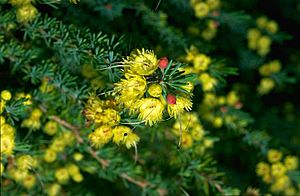Coast featherflower facts for kids
Quick facts for kids Coast featherflower |
|
|---|---|
 |
|
| Conservation status | |
| Scientific classification | |
| Genus: |
Verticordia
|
| Species: |
helichrysantha
|
The Verticordia helichrysantha, often called the coast featherflower or Barrens featherflower, is a beautiful flowering plant. It belongs to the myrtle family, Myrtaceae. This plant is special because it is only found in the south-west part of Western Australia. It's a small, woody shrub with branches that spread out. You can spot its small yellow flowers from May to September.
Contents
What Does It Look Like?
The coast featherflower is a shrub that grows openly, often spreading out. It can reach about 30 cm (12 in) tall and 50 cm (20 in) wide. Its leaves are grouped together and look pale grey-green. They are usually 3 to 8 mm (0.1 to 0.3 in) long and have a rounded end.
The flowers grow alone or in small groups near the leaves. Each flower sits on a short stalk, about 2 to 5 mm (0.1 to 0.2 in) long. The flower cup is small, only about 2 mm (0.1 in) long, and feels smooth and a bit hairy.
The sepals, which are like small leaves protecting the bud, are pale yellow. They are about 4.5 to 5 mm (0.2 in) long and covered in soft, short hairs. They have 4 or 5 feathery parts. The petals are the same yellow colour and stand upright. They are about 3.0 to 3.5 mm (0.1 in) long and shaped like an egg. Their outer surface is covered in soft hairs, and their edges have small, uneven teeth. The style, which is part of the flower's reproductive system, is quite long, about 14 to 17 mm (0.6 to 0.7 in). It curves and sticks out past the petals. This plant usually flowers from May to September or October.
You can tell this species apart from similar plants by its short, greyish leaves and its soft, hairy sepals and petals.
How It Got Its Name
The coast featherflower was first officially described by a scientist named Ferdinand von Mueller in 1867. This description was published in a book called Flora Australiensis by George Bentham. The first samples of the plant were collected by George Maxwell.
Mueller didn't say why he chose the name helichrysantha. However, it might be because its flowers look a bit like the small flowers of another plant group called Helichrysum.
When another scientist, Alex George, looked closely at the Verticordia group in 1991, he placed this species with others that share similar features.
Where It Lives
This featherflower grows in shallow sand, often over a type of rock called spongolite and limestone. You can find it on coastal plains and cliffs, usually in coastal heath areas. It often grows alongside other featherflower types like V. fastigiata and V. habrantha.
Its main home is in an area west of Mount Barren, inside the Fitzgerald River National Park, stretching to Cape Riche. It was once seen near Kamballup in the Stirling Range, but that was a rare sighting. It only grows in the Esperance Plains biogeographic region of Western Australia.
A scientist named Kenneth Newbey first recorded this plant in 1965. But then it wasn't seen again until 1982, when Norm Stevens rediscovered it!
Protecting the Coast Featherflower
The Verticordia helichrysantha is considered a "Threatened Flora" by the Western Australian Government's Department of Parks and Wildlife. It's also listed as "Vulnerable" (VU) under the Australian Government's Environment Protection and Biodiversity Conservation Act 1999 (EPBC Act). This means it's at risk of disappearing if we don't protect it.
Scientists know of only five groups of these plants. Sadly, one group hasn't been seen since 1964, and another since 1986. The three remaining groups have about 25,000 mature plants.
There are several things that threaten this special plant:
- Dieback disease: A plant disease called dieback can harm it.
- Land clearing: Areas where it grows are sometimes cleared for other uses.
- Fire: The wrong types of fires can damage its habitat.
- Mining: Mining activities can destroy its home.
- Four-wheel driving: Off-road vehicles can damage the plants and their environment.
It's important to protect these plants so they can continue to grow in Western Australia.
Growing It in Gardens
The coast featherflower has pretty pale leaves, pink flower buds, and bright yellow flowers. These features make it an attractive plant. However, it hasn't been grown in gardens very often. It's fairly easy to grow new plants from cuttings. It also grows well in places that get a lot of rain in winter.


